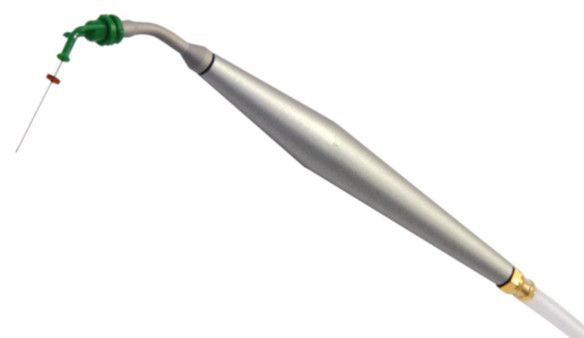Plasma-ApplicatorsPlasma-electrodes, -nozzle and -mouthtray for the wide application in plasma medicine
Dentistry is characterised by a broad range of disease patterns, which are often caused by an infestation of teeth, the gingiva and/or periodontium with germs. Due to the abundance of affected oral regions, tools are required that are anatomically tailored to the treatment site as well as in any way possible.
Plasma-Electrodes

Of all applicators, the variety among the plasma-electrodes is broadest. Given that they are made out of glass and thus being rigid, the possibilities of their application are limited with the result that every treatment region has its own tailored plasma-electrode. Below is a selection of the most commonly used in the doctor's surgery.
Dentine in a given cavity
The most common plasma-electrode for the treatment of the dentine in a given cavity is the caries electrode CA. The unique feature of the CA plasma-electrode are the CA clips, available in three versions for different cavity sizes. They are attached to the CA electrode, help keeping a sufficient distance between the tooth and the plasma-electrode and conduct the microcurrent via a grounding in order to prevent the stimulation of the dental nerve.
Visible Gingiva and Tongue
The soft tissue relents to the plasma-electrode and is usually less sensitive to an electrical stimulation than the tooth making clips like those used by the CA electrode unnecessary. In the case of an existing aphtha, however, treatment with the CA plasma-electrode ist recommended for pain reduction. In plasma therpay, the GI electrode is used for the gingiva. It is available in two versions, where the electrode tip forms either a 90° or 135° angle to the electrode's tube. The TO electrode is designed for the tongue. Its tip is flat and has a large surface, which helps getting rid of germs on the tongue and fight halitosis (bad breath).
Alveole, Root Canal and Gingival Pocket
Root canals and gingival pockets can be treated with the KP plasma syringe together with an attached capillary. For this purpose, the plasma syringe is drawn up, the plasma is generated and thereafter injected into the treatment site. The AV plasma-electrode, like the GI plasma-electrode, is available in two versions and is designed to treat alveoli, whereas the CR plasma-electrode is used in the area of the root canals.
The PA electrode, on the other hand, are used exclusively for the treatment of gingival pockets. With the long PA-L and the short PA-S plasma-electrode, the tip forms a right angle to the elecetrode's tube. But in case of the PA-8 plasma-electrode, the angle is about 135°. Depending on the location and depth of the gingival pocket, different PA plasma-electrodes are qualified for the treatment.
Plasma-Nozzle

The plasma-nozzle is provided only by the Ozonytron-XL, -XP and -XPO. With this applicator, the continuous perfusion with highly concentrated plasma is possible. The plasma flow can be set between 0.2 and 1 litre per minute in order prevent emphysema. The plasma-nozzle is mainly used for the treatment of gingival pockets, but can also be used for cavities and root canals. With plugged on capillaries, even difficult to access oral regions can be treated, which cannot be reached with the plasma-electrodes.
Plasma-Mouthtray
The plasma-mouthtray is available in four sizes allowing the treatment on every patient without extreme dysgnathia (abnormal occlusion). With this applicator, the simultaneous perfusion of all teeth, gingival pockets and the periodontium is possible. For this purpose, the plasma flows in the area of the upper and lower incisors, through the complete set of teeth and is sucked off behind the molars together with the secretion. During the treatment, the plasma-mouthtray attaches itself tightly on the gingiva with the help of negative pressure leading to the creation of a protected atmosphere and preventing the inhalation of excess plasma.
